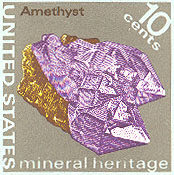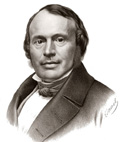
|
History of Geology |

Born: 28 May 1807, Môtier, Switzerland.
Died: 14 Dec. 1873, Boston, U.S.A.
| Abstract | Introduction |
| Major works | American works |
| Later life | Historical assessment |
| Related websites |

|
History of Geology |

Born: 28 May 1807, Môtier, Switzerland.
Died: 14 Dec. 1873, Boston, U.S.A.
| Abstract | Introduction |
| Major works | American works |
| Later life | Historical assessment |
| Related websites |
In 1846, Agassiz immigrated to the United States, and the following year was appointed Professor of Zoology and Geology at Harvard University. He was instrumental in establishing the Museum of Comparative Zoology in 1859, and was active in improving American science education. Agassiz staunchly supported the fixity of species and special creation of man, and thus became an outspoken critic of Darwin's theory of evolution. He began to lose scientific credibility, especially after an expedition to Brazil, when he proclaimed that all Brazil had been covered by ice sheets. Late in life, Agassiz mellowed somewhat regarding Darwin's evolution, but he never really gave up his belief in the fixity of species.
Agassiz had a Protestant upbringing in the western French-speaking portion of Switzerland. His
father was a minister. Agassiz had a typical boyhood with interest in the natural world. He
was handsome and athletic. His family planned a business or ministerial career for him, but
Agassiz wanted neither. He was allowed to attend the Academy of Lausanne, which was a
university prep school. In order to continue his education in 1824, he adopted the strategy
of earning an M.D. degree. He entered medical school at the University of Zurich, the center
of Swiss learning. In 1826, he transferred to the great German university at Heidelburg. He
was a determined and successful student. There he met his future wife, Cécile Braun.
Agassiz continued to exercise his athletic ability and became a first-rate fencer. However,
in 1827 he was stricken by typhoid fever and returned home to recuperate. Later that same
year, he accepted an invitation to study at the new University of Munich. There he developed
a major interest in ichthyology, and he described a Brazilian fish collection. In 1829 he
published a book on Brazilian fish, which he dedicated to Cuvier. On this basis, Agassiz
earned the Ph.D. degree in natural science, but it was not the M.D. degree his family wanted.
He returned to the University of Erlangen in 1830 and completed the M.D.
Agassiz undertook a tour of glaciers in the Chamonix district with de Charpentier in 1836. He
was convinced by de Charpentier of former glacier activity in the Alps, a concept which he
expanded to global proportions. In 1837, Agassiz gave an address to the Swiss Society of
Natural History wherein he introduced the idea of a great "Ice Age," in which vast sheets of
ice had covered everything from the North Pole to the Mediterranean and Caspian Seas. Agassiz
followed with Études sur les glaciers in 1840, the first book on glaciology and
glacial geomorphology. He provided further documentation in 1847 with Système
glaciers. His advocacy of the newly developing glacial theory helped to boost
his renowned as a naturalist.
The cosmic significance of the Ice Age was important to Agassiz. In his mind, the biblical
deluge was replaced by glaciation—a different catastrophy, but with the same result. The
glacial theory also was adopted quickly by non-catastrophists, such as Lyell and Darwin.
De Charpentier, who had introduced Agassiz to glaciers, and Schimper, who earlier coined the term Eiszeit (German for ice age), felt slighted by Agassiz. They became enemies over the matters of priority and perceived lack of acknowledgement of previous scientific work.
By 1845 Agassiz had mounting personal problems including debts and failure of a scientific
publishing organization he had set up. His wife left him and returned to Germany. At age
38, Agassiz had reached a turning point in his life. He received an offer from the Prussian
king to finance an expedition to America. Agassiz arranged an appointment at the Lowell
Institute in Boston and arrived in 1846. He immediately fell in love with the United States.
His eldest son, Alexander, aged 13, joined Louis Agassiz in 1849. In 1850 he married
Elizabeth Cabot Cary and two other daughters joined them. Agassiz was awarded the Prix
Cuvier in 1852 by the French Academy of Sciences for Poissons fossiles. He sold
his huge private collection of fossils to Harvard University in 1853, and this became the
nucleus of the museum.
In 1855 Agassiz launched his greatest project to date. He began a 10-volume set on
Contributions to the natural history of the United States. He planned to do in
America what Humboldt had done in Europe. The first two volumes appeared in 1857 to
tremendous anticipation. However, reviews were mixed and the entire set was never
completed. Agassiz staunchly defended the fixity of species and Cuvier's catastrophism.
He failed to deal with species variation; Agassiz was losing touch with science.
Agassiz's persistant efforts in fund raising for a museum finally were rewarded in 1857
with groundbreaking for a new Museum of Comparative Zoology. The same year, Darwin sent
Agassiz a copy of his book on the origin of species, which was contrary to Agassiz's
unswerving adherence to fixity of species. Agassiz went so far as to support "plural
origins of mankind," which provided scientific authority to racial supremacists and
pro-slavery forces. He became quite dogmatic and opposed to the concept of evolution
in any form.
Agassiz took a summer trip in party with businessmen and congressmen in 1868 across the western plains region, including Kansas, Nebraska, Minnesota and Wyoming. He was perhaps the most famous scientist to have visited Kansas at that point in time. He found unmistakable evidence for glaciation and recognized that the major rivers—Ohio, Mississippi and Missouri—had originated for drainage of glacial meltwater, which proved to be a highly significant observation.
His last major expedition was a Coast Guard oceanographic survey in 1872 from the Caribbean, around South America, to
California. Agassiz had by this time begun to mellow toward Darwin's concept of evolution,
and he hoped to recreate Darwin's voyage on the Beagle. He recognized true glacial
features in the Andes, which served to reinforce his erroneous Brazilian idea. He was unable
to appreciate fully the significance of species in the Galapagos and never really gave up his
belief in the fixity of species.
Back in Boston, he plunged into continued operation of the museum. In Decemeber 1873, he was
taken ill suddenly and died on the 14th at age 66.
Agassiz was a provocative figure, one who dared to promote radical ideas—the existence of an
ice sheet—at a time when little direct evidence was available. The modern ice sheets in Greenland and Antarctica were then unknown features. Although his more extreme concepts eventually proved wrong, he still deserves credit for stimulating a great deal of
scientific research and public awareness concerning earth history and the ice age. In 1879,
glacial Lake Agassiz (in North Dakota, Minnesota, Saskatchewan and Manitoba) was named to
recognize Agassiz's prominent role in developing the glacial theory.
Return to history of geology syllabus or schedule.Introduction
Agassiz was a Swiss-American vertebrate paleontologist, zoologist, geomorphologist, and renowned
natural scientist, who was quite influential during his time. He was the father of Alexander
Agassiz, a noted zoologist and oceanographer. Louis Agassiz's primary work was on
classification of living and fossil fish—ichthyology. He also promoted the concept of a
great "Ice Age" in the recent geological past.Major Works of Agassiz
Agassiz studied in France during 1831-32 working closely with Cuvier on fossil fish at
the Museum of Natural History in Paris. There he became friends with Humboldt, who made a
large cash gift to help Agassiz continue his work. In 1832, Agassiz obtained an appointment
as professor of natural science at the new Academy of Neuchâtel in Switzerland. He
returned home, settled into the job, married Cécile, and had three children. He
commenced a decade of publishing and writing that resulted in Recherches sur les poissons
fossiles (1833-43), in which more than 1700 fossil fish are described and classified.
This was a major accomplishment in vertebrate paleontology, whereby Agassiz gained considerable
fame as a paleontologist. He developed the firm belief in fixity of species and catastrophism
of Cuvier.

Portrait of Louis Agassiz by Antoine Sonrel in the mid-19th century. In the public domain; obtained from Wikimedia Commons. American Works of Agassiz
Agassiz was received enthusiastically in the United States. He travelled widely and obtained
fat lecture fees. By 1847 the Prussian grant was gone, and Agassiz decided to remain
permanently in the U.S. He became professor of zoology and geology at Harvard University,
where he began a museum in 1848. He undertook a grand lecture tour and expedition to the
Lake Superior region. Meanwhile Cécile died, which was a great blow as he still loved
her deeply. A public scandal broke out about his marital life and treatment of scientific
assistants. In the end Agassiz was completely vindicated of any wrongdoing.Later Life of Agassiz
Agassiz's scientific achievements were recognized in 1861 with the Copley Medal from the
Royal Society of London. Thus, he joined an elite group that included Lyell and Humboldt.
In 1865-66 he led an expedition to Brazil. This was a major project that involved many people,
and more than 80,000 fish specimens were collected from the Amazon. Agassiz was attempting to
duplicate the achievements of Humboldt. Agassiz recognized the effects of glaciation in Brazil
and concluded that Brazil had been covered by vast ice sheets as the northern hemisphere had
been. This conclusion astounded other scientists, who discounted the idea, but Agassiz furnished little
actual proof. Agassiz was gradually losing his credibility and causing damage to the glacial
theory. One result of this expedition was A journey to Brazil (1868) by Prof. and Mrs.
Agassiz, a popular work that was poorly received by the amazed scientists who bothered to
read it.Historical Assessment
Agassiz's scientific accomplishments comprise a mixture of results. He was certainly the
world's foremost authority on fossil and living fish, he popularized the idea of a
geologically recent ice age, and he founded an important natural history museum. He
was a charismatic figure who generated strong feelings—both like and dislike among his
colleagues and the general public. His influence was particularly strong in the United
States, where he held great respect. Nonetheless, it could be argued that much of his
fame rested upon his ability to promote himself and his ideas rather than with original
scientific research.

Statue of Louis Agassiz toppled by the San Francisco earthquake in 1906 at Stanford University. An ironic statement on Agassiz's scientific accomplishments and reputation. In the public domain; obtained from Wikimedia Commons.  More on development of the
glacial theory.
More on development of the
glacial theory. Related Websites
Related Websites
Reference

© J.S. Aber (2013).